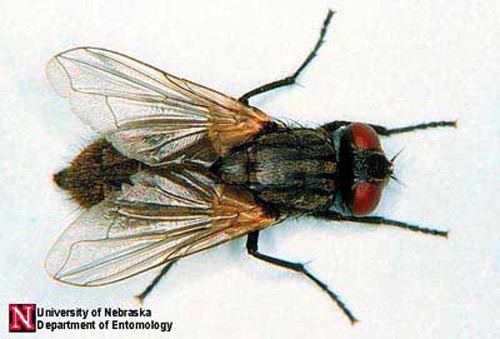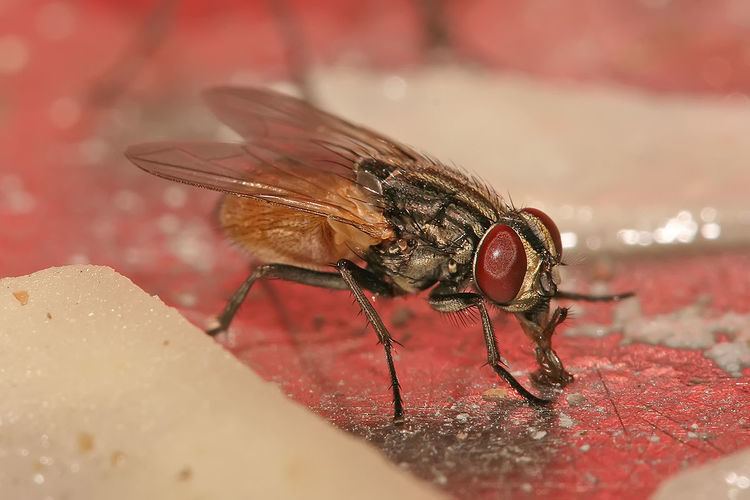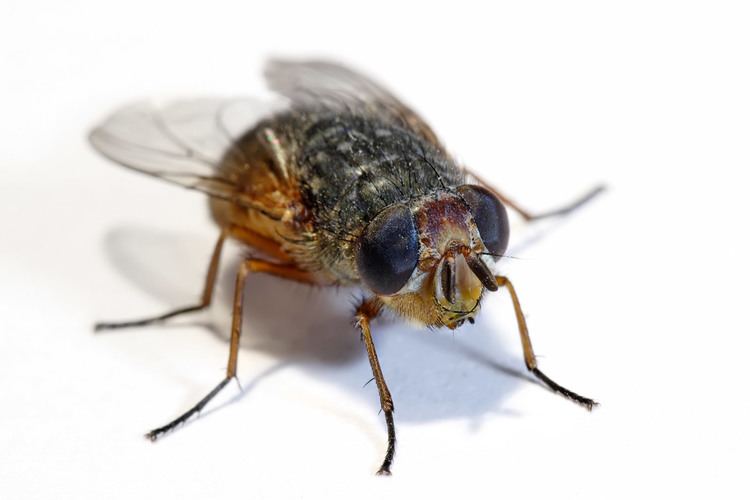Scientific name Musca domestica Higher classification Musca | Genus Musca Order Fly Rank Species | |
 | ||
Lifespan Male: 28 days (In High Temperature, Low activity, Adult) | ||
Epic queen housefly giving birth ewwwww
The housefly (also house fly, house-fly or common housefly), Musca domestica, is a fly of the suborder Cyclorrhapha. It is believed to have evolved in the Cenozoic era, possibly in the Middle East, and has spread all over the world. It is the most common fly species found in habitations. Adult insects are grey to black with four dark longitudinal lines on the thorax, slightly hairy bodies and a single pair of membranous wings. They have red eyes, and the slightly larger female has these set further apart than the male.
Contents
- Epic queen housefly giving birth ewwwww
- Description
- Life cycle
- Aging
- Sex determination
- Evolution
- Relationship with humans
- As a transmitter of disease
- Potential in waste management
- References

The female housefly usually only mates once and stores the sperm for later use. She lays batches of about 100 eggs on decaying organic matter such as garbage, carrion or feces. These soon hatch into legless white maggots which after 2 to 5 days of development transform into reddish-brown pupae, about 8 mm (0.3 in) long. Adult flies normally live for 2 to 4 weeks but can hibernate during the winter. The adults feed on a variety of liquid or semi-liquid substances beside solid materials which have been softened by saliva. They carry pathogens on their bodies and in their feces and can contaminate food and contribute to the transfer of food-borne illnesses. For these reasons they are considered pests, but have been used in the laboratory in research into ageing and sex determination.

Description

Adult houseflies grow to 8–12 millimetres (0.3–0.5 in) long. The thorax is gray or sometimes even black, with four longitudinal dark lines on the back. The whole body is covered with hair-like projections. The females are slightly larger than the males, and have a much larger space between their red compound eyes.
Pupae can range from about 8 to 20 mg under different conditions.

Like other Diptera (meaning "two-winged"), houseflies have only one pair of wings; what would be the hind pair is reduced to small halteres that aid in flight stability. Characteristically, the media vein (M1+2 or fourth long vein of the wing) shows a sharp upward bend.
Species that appear similar to the housefly include:
The mouth parts of the fly are characterised by the proboscis, a tubular protrusion found on the anterior end of many insects. At the end of the proboscis, the labium is found. The structure is a sponge-like organ that is characterised by many groves, called pseudotrachae. The purpose of this pseudotrachea is to take up liquids. The absorbed liquid is eventually transported to the oesophagus.
Life cycle
Each female fly can lay approximately 500 eggs in a lifetime, in several batches of about 75 to 150. The eggs are white and are about 1.2 mm in length. Within a day, larvae (maggots) hatch from the eggs; they live and feed on (usually dead and decaying) organic material, such as garbage, carrion or feces. They are pale-whitish, 3–9 mm long, thinner at the mouth end, and have no legs. Their life cycle ranges from 14 to 90 days. At the end of their fourth instar, the maggots crawl to a dry, cool place and transform into pupae, coloured reddish or brown and about 8 mm long. The adult flies then emerge from the pupae. (This whole cycle is known as complete metamorphosis.) The adults live from two weeks to a month in the wild, or longer in benign laboratory conditions. Having emerged from the pupae, the flies cease to grow; small flies are not necessarily young flies, but are instead the result of getting insufficient food during the larval stage.
Some 36 hours after having emerged from the pupa, the female is receptive for mating. The male mounts her from behind to inject sperm. Copulation takes a few seconds to a couple of minutes. Normally, the female mates only once, storing the sperm to use it repeatedly for laying several sets of eggs.
The flies depend on warm temperatures; generally, the warmer the temperature, the faster the flies will develop.
Aging
Because the somatic tissue of the housefly consists of long-lived post-mitotic cells, it can be used as an informative model system for understanding cumulative age-related cellular alterations. Agarwal and Sohal studied the level of the oxidative DNA damage 8-hydroxydeoxyguanosine (8-OHdG) in houseflies. They found that the level of 8-OHdG increased with age of the flies. They also found an inverse association of 8-OHdG level with life expectancy of the flies. They concluded that their results support the hypothesis that oxidative molecular damage is a causal factor in senescence (aging). These findings are in accord with the general view that oxidative DNA damage, particularly in post-mitotic tissues, is a principal cause of aging. (Also see DNA damage theory of aging.)
Sex determination
The housefly is an object of biological research, mainly because of one remarkable quality: the sex determination mechanism. Although a wide variety of sex determination mechanisms exist in nature (e.g. male and female heterogamy, haplodiploidy, environmental factors), the way sex is determined is usually fixed within one species. The housefly is thought to exhibit several different mechanisms for sex determination, such as male heterogamy (like most insects and mammals), female heterogamy (like birds) and maternal control over offspring sex. The exact mechanism of sex determination in the housefly is, however, still unresolved.
Evolution
Even though the order of flies (Diptera) is much older, true houseflies are believed to have evolved in the beginning of the Cenozoic era. They are thought to have originated in the southern Palearctic region, particularly the Middle East. Because of their close, commensal relationship with humans, they probably owe their worldwide dispersal to co-migration with humans.
The house fly is the most common of all domestic flies, accounting for about 91% of all flies in human habitations, and indeed one of the most widely distributed insects, found all over the world.
Relationship with humans
House flies are capable of carrying over 100 pathogens, such as those causing typhoid, cholera, salmonellosis, bacillary dysentery, tuberculosis, anthrax, ophthalmia, and parasitic worms. Some strains have become immune to the most common insecticides.
House flies feed on liquid or semiliquid substances beside solid material which has been softened by salivating or vomit. Because of their large intake of food they deposit feces constantly, which is one of the factors that makes the insect a dangerous carrier of pathogens. Although they are domestic flies, usually confined to human habitations, they can fly for several miles from the breeding place. They are active only in daytime, and rest at night, e.g., at the corners of rooms, ceiling hangings, cellars, and barns, where they can survive the coldest winters by hibernation, and when spring arrives, adult flies are seen only a few days after the first thaw.
As a transmitter of disease
Mechanical transmission of organisms on its hairs, mouthparts, vomitus and feces:
Potential in waste management
The ability of housefly larvae to feed and develop in a wide range of decaying organic matter is important for recycling of nutrients in nature. Research suggests that this adaptation may be exploited to combat ever-increasing amounts of waste. Housefly larvae can be mass-reared in a controlled manner in animal manure, thus reducing the bulk of waste and minimizing environmental risks of its disposal. Harvested maggots may be used as feed for animal nutrition.
